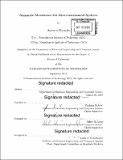| dc.contributor.advisor | Vladimir Bulović and Jeffrey H. Lang. | en_US |
| dc.contributor.author | Murarka, Apoorva. | en_US |
| dc.contributor.other | Massachusetts Institute of Technology. Department of Electrical Engineering and Computer Science. | en_US |
| dc.date.accessioned | 2020-03-09T18:51:58Z | |
| dc.date.available | 2020-03-09T18:51:58Z | |
| dc.date.copyright | 2019 | en_US |
| dc.date.issued | 2019 | en_US |
| dc.identifier.uri | https://hdl.handle.net/1721.1/124068 | |
| dc.description | Thesis: Ph. D., Massachusetts Institute of Technology, Department of Electrical Engineering and Computer Science, 2019 | en_US |
| dc.description | Cataloged from PDF version of thesis. | en_US |
| dc.description | Includes bibliographical references (pages 296-303). | en_US |
| dc.description.abstract | Micro- and nano-electromechanical systems (MEMS/NEMS) are a technology field that branched out of semiconductor integrated circuit (IC) manufacturing about four decades ago, and one that forms the backbone of the Internet of Things era. However, as MEMS devices are becoming ubiquitous, they are also being limited by the narrow platform of IC material sets and design parameters, which significantly constrain prevalent MEMS functions and applications. In order to expand the application space of MEMS/NEMS, it is imperative that novel material platforms and manufacturing methods are considered. The basic building block of the approach demonstrated in this work is a suspended membrane of nanoscale thickness (or "nanomembrane") that is first separately fabricated, and then additively donated via contact-transfer printing to complete a nanostructured variable-capacitance device. | en_US |
| dc.description.abstract | The process simplifies fabrication of mechanically-active nanostructured elements over relatively large areas, and yields electromechanical systems with low operating voltages and high energy efficiency. Specifically, transfer printing and suspension of 125-nm-thick gold nanomembranes of areas on the order of 10 mm2 and larger is demonstrated, and the resulting structures are utilized as electrostatic microspeakers. These purely metallic membranes exhibit ideal spring-like behavior at human auditory frequencies, devoid of any mass-related mechanical resonances. This in turn results in the widest uniform bandwidth in the human auditory range demonstrated for portable acoustic actuators. Electrostatic microspeakers enabled by these nanomembranes exhibit superior acoustic performance in terms of output acoustic pressure frequency response uniformity in both free-field and pressure-field radiation, below 10 Volts actuation. | en_US |
| dc.description.abstract | This is in contrast to state-of-the-art electrostatic speakers that require high actuation voltages often in excess of 100 Volts, and other prevalent voice-coil technologies with high resistive power loss and low electromechanical conversion efficiency. The free-field and pressure-field performance of these gold nanomembrane electrostatic microspeakers is corroborated via analytical models derived using the inhomogeneous acoustic wave equation, via lumped parameter models, and via finite element analysis. The metallic nanomembranes are also integrated with polymeric materials and organic semiconductors to demonstrate vertical-cavity surface-emitting lasers (VCSELs) that are tuned over tens of nanometers with electrostatic actuation below 10 Volts. | en_US |
| dc.description.abstract | The multi-domain nature of this work aims to demonstrate the versatility of contact-transfer printed metallic nanomembranes, and their potential as a superior alternative to conventional semiconductor and piezoceramic thin films for a variety of MEMS/NEMS sensor and actuator applications. | en_US |
| dc.description.statementofresponsibility | by Apoorva Murarka. | en_US |
| dc.format.extent | 303 pages | en_US |
| dc.language.iso | eng | en_US |
| dc.publisher | Massachusetts Institute of Technology | en_US |
| dc.rights | MIT theses are protected by copyright. They may be viewed, downloaded, or printed from this source but further reproduction or distribution in any format is prohibited without written permission. | en_US |
| dc.rights.uri | http://dspace.mit.edu/handle/1721.1/7582 | en_US |
| dc.subject | Electrical Engineering and Computer Science. | en_US |
| dc.title | Nanoscale membranes for electromechanical systems | en_US |
| dc.type | Thesis | en_US |
| dc.description.degree | Ph. D. | en_US |
| dc.contributor.department | Massachusetts Institute of Technology. Department of Electrical Engineering and Computer Science | en_US |
| dc.identifier.oclc | 1142180702 | en_US |
| dc.description.collection | Ph.D. Massachusetts Institute of Technology, Department of Electrical Engineering and Computer Science | en_US |
| dspace.imported | 2020-03-09T18:51:57Z | en_US |
| mit.thesis.degree | Doctoral | en_US |
| mit.thesis.department | EECS | en_US |
